The entire history of post-antiquity is built on a series of lies, including, among others, that of the false birth of Islam in Arabia, as well as the perception of “Arabs / Sarazins” by the Catholic Church and the role we assigned to them.
The term “Arabic” only appeared when modern Europe was interfering with the Ottoman Empire, at least officially. A few bands of nomadic villains scattered in a huge desert does not make a people capable of suddenly creating a religion and imposing it by force on nations, which were more powerfull in all areas; social, military, technical, cultural, etc. whereas some were located thousands of kilometers from the Hejaz desert.
According to the official history of Islam written by Catholic and Muslim fanatics, the Sarazens were those who were cited as the conquerors who spread the Islamic faith in the 700 hundreds. A faith whose sacred book would only exist a century later.
It seems that the Europeans took ingredients they had at home and made a great story for Islam. Let’s see whom the sarazins were in the middle ages.
In his book “Our ancestors the Saracens of the Alps” (nos ancêtres les Sarrasins des Alpes), the French historian Joseph Henriet demonstrates that those whom history has named Sarazens were not Arabs. They would be, more generally, pagans, peoples who had not converted to Christianity, and assimilated to Muslims by a confusion due to the idea, formerly believed, that Islam adapted certain traits estimated prior to Christianity. Heresy was generally regarded as a superficial garment given to old beliefs; this was also the case of Arianism, which had been adopted by the Burgundians. In the heart of the Alps, according to Henriet, different heretics and pagans could live side by side, but at the end of the day, they were no stranger to the area: it was a native people, settled in places since the beginning. They are those whom we today call Ligures, whose language was no doubt close to Basque. In opposite from the Allobroges, they remained at the top of the mountains or in the depths of the valleys.
According to Henriet, the description of “Sarazins” by medieval authors refers to indigenous peoples, not Eastern invaders.
These natives would have preserved for a long time, in the Middle Ages, their pagan cults, their way of mountainlife, and also their habits of plundering the convoys of travelers when their productions were insufficient. Christian writers, living in the cities, would therefore have claimed them to be “Sarazins”, referring both to the terror they inspired, and to their ignorance of the Christian religion.
One day, perhaps soon, thanks to the rapid progress of genetic sience, honorable scientists should be able to determine with certainty whom the Sarazins of the Alps were. In the meantime, Joseph Henriet’s hypothesis seems to be particularly convincing …






Leave a Comment